Knowing Where to Use @Functions and @Commands
The Formula language can be used in agents , replication formulas, views, forms, actions, pages, and fields. Most often, you write formulas in the Programmer's pane. In some cases, if an item allows a formula to be written only in the Formula language, there is usually a separate window in which to construct the formula. An example is a formula for a keyword field. (Using the Formula window is discussed in the next section, "Working with the Formula Window.") If there are multiple ways to program an event or object, you do so in the Script area of the Programmer's pane. Objects that can be programmed with Formula language @Functions and @Commands have Formula as a choice in the Run drop-down list.
Working with the Formula Window
The Formula window appears in items that are programmable only with the Formula language. Examples are the Hide Action formula and a keyword field formula. Two window types are available: One is embedded in the properties box, and the other is a modal window launched from the Formula Window button on the properties box. See Figure 12.1 for an example of both types.
Figure 12.1. You can compose a keyword field formula in the properties box or in the larger, modal window; note the formula in the properties box and the Fields and Functions dialog box.
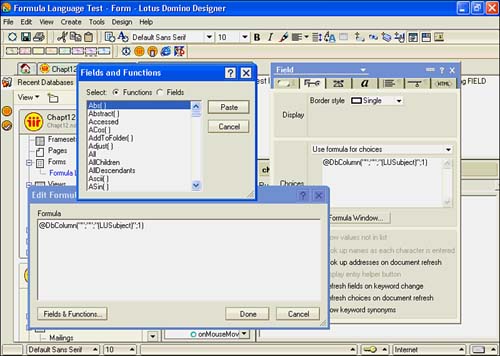
The space inside the properties box is quite limited, but if you have a simple formula to enter, it will often suffice. You can see this window in both Figures 12.1 and 12.2.
Figure 12.2. The syntax checker buttons appear when formulas are modified or created.
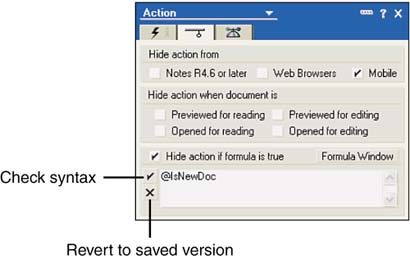
When you enter a formula directly in the embedded formula window in the Field properties box, there is a syntax checker available, as shown in Figure 12.2. The syntax checker consists of two buttons, one with a check mark on it and the other with a x symbol. Whenever you enter or modify a formula, these two buttons appear. Clicking the check mark button tests the syntax of the formula. Clicking the x button restores the syntax to its original state. (This same syntax checker is available in the Design pane, discussed in the next section.) In any case, you can't save a formula that is not syntactically correct. You can, however, save a formula that has logic errors even though the syntax is correct, so be careful and test your work.
TIP
To save your work on a formula that is not syntactically correct, enclose the entire formula in quotes or curly braces and place a REM at the beginning of the line. Be sure to use the slash character if there are embedded quotes in the formula. You can later return to the formula, remove the quotes or curly braces, and continue work.
The second type of window is a modal dialog box. Figure 12.1 shows a keyword formula being constructed in the modal Formula window using @DBColumn( ). This larger window is launched from the Formula Window button in the properties box. In addition to having a larger area in which to work, the formula window has a Fields and Functions button that launches a pick list for database fields and @Functions. Unfortunately, there is no syntax checker for this window. However, when you click the Done button, the syntax is tested ; you can't exit the modal window unless the syntax is correct.
Writing Formulas in the Script Area
The Design pane is discussed in Chapter 3 and is covered briefly here in the context of writing formulas. Figure 12.3 shows an input validation formula for a field. This formula ensures that the user cannot save the document without entering information into the cSubject field.
Figure 12.3. The Script area is used to construct many types of formulas, including the formula for the Input Validation event.
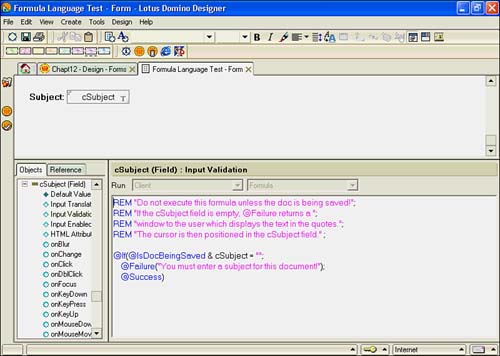
To the left of the Script area, you will notice that the Info List is open to the Objects tab and that the Input Validation event is selected. The formula in Listing 12.4 is typical of fields with required entry.
Listing 12.4 Input Validation for the cSubject Field
REM "Do not execute this formula unless the doc is being saved!";
REM "If the cSubject field is empty, @Failure returns a ";
REM "window to the user which displays the text in the quotes.";
REM "The cursor is then positioned in the cSubject field." ;
@If(@IsDocBeingSaved & cSubject = "";
@Failure("You must enter a subject for this document!");
@Success)
If you make a syntax error, Domino Designer catches it when you try to exit the field or save the form. Clicking the syntax checker button also catches any mistakes. If there is an error, a message appears at the bottom of the Design pane and the offending entry is changed to red. Figure 12.4 shows an error condition in the formula listed earlier.
Figure 12.4. An extra right parenthesis was placed at the end of the @If() statement to generate an error; the error message is at the bottom of the Script area.
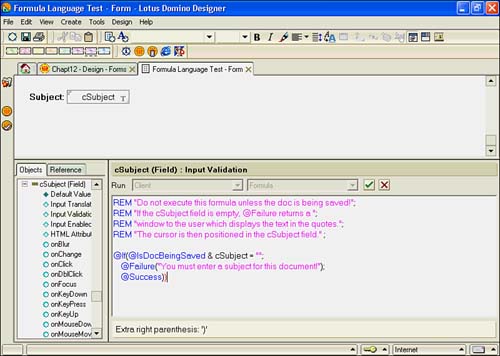
Figures 12.3 and 12.4 showed the Objects tab in the Programmer's pane, which lists all of the programmable events for the object. The Reference tab contains extensive help for programming the object. Figure 12.5 shows the Reference tab for the Input Validation event. In the drop-down list, you can choose from Database Fields, Formula @Commands, and Formula @Functions. For events that have other scripting languages available, choices appear for those languages as well. Selecting an item in the Reference list and clicking Help opens a separate application window with the appropriate Help document displayed. The Paste button can be clicked to copy the field or command into the Script area.
Figure 12.5. The Reference tab allows programmers to choose fields and language components to use in the current object.
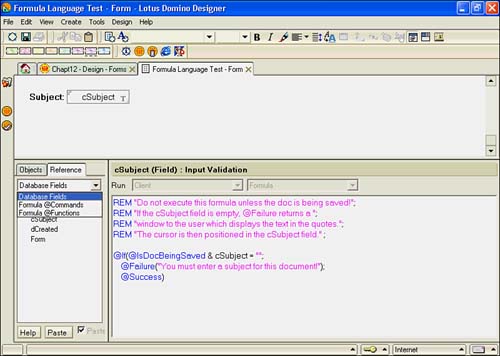
Part I. Introduction to Release 6
Whats New in Release 6?
- Whats New in Release 6?
- A Brief History of Lotus Notes
- Major Features of Lotus Notes
- Types of Applications
- Whats New in Domino Designer?
- New Design Element Features
- New Language Features
The Release 6 Object Store
- The Release 6 Object Store
- Defining a Domino Database
- Understanding the Database Structure
- Creating a Database
- Working with Database Properties
- Understanding Design Templates
- Creating Your Own Templates
- Inheriting Designs from Templates
- Using Templates to Replicate Design Changes
- Using Templates as Design Libraries
- Archiving Versions with Templates
The Integrated Development Environment
- The Integrated Development Environment
- Working in the Application Design Environment
- Working with the Properties Box
- Understanding the Work Pane
- Using the Programmers Pane
- Understanding the Info List
- Understanding the Action Pane
- Customizing the Tools Menu
- Printing Source Code
- Using the HTML Editor
- Locking Design Elements
Part II. Foundations of Application Design
Forms Design
- Forms Design
- Designing Forms
- Setting Form Properties
- Working with Text Properties
- Working with Fields
- Writing Formulas in Fields
Advanced Form Design
- Advanced Form Design
- Working with Tables
- Using Graphic Objects on Forms
- Working with Form-Level Events
- Using Form Actions
- Working with Hotspots
- Understanding Sections and Section Properties
- Using Layout Regions
- Working with Special Forms
- Creating Reusable Design Objects
- Using Embedded Elements
- Using the Form Design Document
Designing Views
- Designing Views
- Defining the Elements of a View
- Creating a View
- Setting View Properties
- Creating Advanced View Selections
- Adding and Editing View Columns
- Using View Column Properties
- Adding Actions to a View
- Creating Calendar Views
- Understanding Folders
Using Shared Resources in Domino Applications
- Shared Resources
- Sharing Images Within a Database
- Creating Shared Files
- Creating Shared Applets
- Shared Code
- Creating Subforms
- Creating Shared Fields
- Creating Shared Actions
- Script Libraries
- Database Resources
Using the Page Designer
- Using the Page Designer
- Understanding Pages
- Working with the Page Properties Box
- Using the Page Designer
- Adding Layers to Your Pages
Creating Outlines
- Creating Outlines
- Creating an Outline
- Working with Outline Entries
- Embedding Outlines
- Adding an Outline to a Frameset
Adding Framesets to Domino Applications
- Adding Framesets to Domino Applications
- Creating a Frameset
- Using the Frameset Designer
- Working with Frames
- Viewing the HTML Source of Your Frameset
- Launching the Frameset
Automating Your Application with Agents
- Automating Your Application with Agents
- Working with Agents
- Creating an Agent
- Working in the Agent Builder Design Window
- Using @Commands in Agents
- Putting Your Agent to Work
- Creating a Complex Agent
- Using LotusScript in Agents
- Creating Web Agents Using Formulas and LotusScript
- Using Java in Agents
- Testing and Debugging Agents, the Agent Log, and Agent Properties
- Agent Properties via the Agent InfoBox
Part III. Programming Domino Applications
Using the Formula Language
- Using the Formula Language
- Overview of the Formula Language
- Knowing Where to Use @Functions and @Commands
- Formula Syntax
- Limitations of the Formula Language
- Working with Statements
- Using Logical @Functions
- Working with Date and Time @Functions
- Working with Strings
- Getting Session and User Information
- Working with Documents
- Retrieving Data with @DbColumn and @DbLookup
- Working with Lists
- Getting User Input
- Controlling the Flow of a Formula
- Error Handling
Real-World Examples Using the Formula Language
- Real-World Examples Using the Formula Language
- Programming Practices
- Using Formulas in Forms and Subforms
- Writing Field Formulas
- Writing View Formulas
- Using Hide When Formulas
- Working with Forms, Views, and Shared Actions
Writing LotusScript for Domino Applications
- Writing LotusScript for Domino Applications
- Software Construction
- Fundamental Elements of LotusScript
- New Technologies and LotusScript
Real-World LotusScript Examples
- Real-World LotusScript Examples
- Real-World Example 1: Importing a Delimited Text File
- Real-World Example 2: Delete a Parent Document and All Its Children: DeleteParentAndChildren
- Real-World Example 3: Schedule an Agent Robot to Refresh All the Documents in a View: Robot-DailyRefreshAllDocs
- Real-World Example 4: Return a Web User to the Place Where He Started After a Document Is Submitted: WebQuerySave-DocSubmit
Writing JavaScript for Domino Applications
- Writing JavaScript for Domino Applications
- What Is JavaScript?
- JavaScript Is Not Java
- JavaScript and the Domino IDE
- The Document Object Model
- JavaScript Support in Domino 6
- When to Use JavaScript
- A Look at JavaScript in Domino
- JavaScript Libraries in Domino
- JavaScript Principles 101
- Syntax and Command Blocks
- Statements
- Output
- Functions
- Objects
- Input Validation
- Validating Check Boxes
- Validating Radio Buttons
- Validating Selection Lists
- Calculations
- JavaScript Application
Real-World JavaScript Examples
- Real-World JavaScript Examples
- Real-World Example 1: Dynamic Drop-Down Lists on the Web
- Real-World Example 2: Dialog Boxes and window. opener on the Web
- Real-World Example 3: Dynamic Tables
- Real-World Example 4: Useful JavaScript Utilities
Writing Java for Domino Applications
- Writing Java for Domino Applications
- Introduction to Java
- Choosing a Java Solution in Domino
- Understanding the Notes Object Interface
- Writing Java Agents
- Using Other Java IDEs
- Other Uses for Java
Real-World Java Examples
Enhancing Domino Applications for the Web
- Enhancing Domino Applications for the Web
- Whats New in Designer 6
- Understanding the Domino Web Application Server
- Understanding the Basics of HTML
- Using HTML in Domino Designer
- Adding Power with Domino URLs
- Views and Forms Working Together on the Web
- Incorporating Flash into Your Web Pages
- What Its All About: XML Exposed
- How Does Domino Use XML?
Part IV. Advanced Design Topics
Accessing Data with XML
Accessing Data with DECS and DCRs
- Accessing Data with DECS and DCRs
- What Is DECS?
- The External Data Source
- DECS Administrator
- Creating the Activity
- Accessing the Application
- DECS Summary
- Data Connection Resources
- DCR Example
- Tips on External Data Access
Security and Domino Applications
- Security and Domino Applications
- How Does Domino Security Work?
- Enabling Physical Security
- Setting Server Access
- Database Access Control Lists
- The Role of the Domino Directory in Application Security
- ACL Privileges
- Enabling Database Encryption
- Using Roles
- Implementing View-Level Security
- Implementing Form-Level Security
- Implementing Document-Level Security
- Applying Field-Level Security
- Hiding the Design of Your Application
Creating Workflow Applications
- Creating Workflow Applications
- The Evolution of Groupware
- Introducing Workflow
- Creating Mail-Enabled Applications
- Using Triggers to Send Email
- Sending Mail with LotusScript
Analyzing Domino Applications
Part V. Appendices
Appendix A. HTML Reference
Appendix B. Domino URL Reference
EAN: 2147483647
Pages: 288
